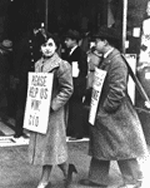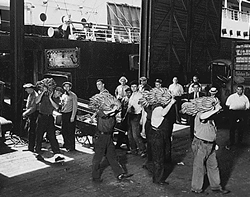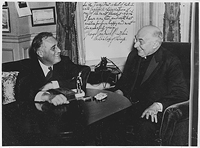Spotlight Archive
With Labor Day right around the corner, we look back at the relationship, sometimes contentious, often cooperative, between Catholics and organized labor in the United States.
 The Catholic Church's teachings promote justice in wages and worker solidarity while defending private property and the rule of law. Catholic priests and laity have filtered Church teaching into their particular social, economic, and political situations in various and sometimes conflicting ways. Part of a church growing to nearly one-quarter the American population in the late twentieth century, Catholic connections to labor are naturally diverse. Catholics have been prominent in union membership and leadership; they have also been well represented among business managers, executives, and conservative political figures. The record of the Catholic hierarachy is similarly varied. At times, bishops’ statements and actions supported forthrightly the aims of organized labor; at other times, their silence or criticism manifested a more skeptical attitude.
The Catholic Church's teachings promote justice in wages and worker solidarity while defending private property and the rule of law. Catholic priests and laity have filtered Church teaching into their particular social, economic, and political situations in various and sometimes conflicting ways. Part of a church growing to nearly one-quarter the American population in the late twentieth century, Catholic connections to labor are naturally diverse. Catholics have been prominent in union membership and leadership; they have also been well represented among business managers, executives, and conservative political figures. The record of the Catholic hierarachy is similarly varied. At times, bishops’ statements and actions supported forthrightly the aims of organized labor; at other times, their silence or criticism manifested a more skeptical attitude.
A heavily immigrant church, the roots of American Catholic labor attitudes reach into Europe. The rise of industrial organization spurred a Catholic movement for social reform led by Bishop Wilhelm von Ketteler of Mainz (1811–1877), while in many quarters Catholicism remained closely tied to the old regimes of Europe and to the principle of aristocratic privilege.
From the onset of significant immigration in the 1840s, the Church in the United States was predominantly urban, with both its leaders and congregants usually of the laboring classes. Over the course of the second half of the nineteenth century, nativism, anti-Catholicism, and anti-unionism coalesced in Republican politics, and Catholics gravitated toward unions and the Democratic Party.
The Knights of Labor was the earliest labor organization in the United States, and it is estimated that at least half its membership was Catholic (including its president from 1881 forward, Terence Powderly). Yet the organization came under scrutiny from some bishops because of its similarity to other “secret societies” (e.g., the Masons) that the Church forbade its followers to join. The matter was resolved in 1887 when Cardinal James Gibbons of Baltimore interceded in Rome against a proposed condemnation of the Knights.
This was the context in which Pope Leo XIII wrote an encyclical letter that articulated the teaching of the Church with a view to the “new things”of the modern world. In Rerum Novarum (1891), Leo criticized the concentration of wealth and power and upheld the right of voluntary association, specifically commending labor unions. At the same time, he reiterated the Church’s defense of private property, condemned socialism, and emphasized the need for Catholics to form and join unions that were not compromised by secular and revolutionary ideologies.
Rerum Novarum provided new impetus for Catholics to become active in the labor movement, even if its exhortation to form specifically Catholic labor unions was widely interpreted as irrelevant to the pluralist context of the United States. While atheism underpinned many European unions and stimulated Catholic unionists to form separate labor federations, American unions’ religious neutrality provided no such impetus. American Catholics, in contrast, seldom dominated unions, but they exerted influence across organized labor. Catholic union members and leaders played important roles in steering American unions away from socialism.
 Catholics remained disproportionately Democrat and working class through the first half of the twentieth century, which witnessed the first appearance of the “labor priests” who would become familiar characters to employers and workers across the country. Labor priests supported organized labor by providing spiritual and material support for strikers, preaching the benefits of organizing, and mediating between workers and owners. Among the best known were Peter Dietz in Milwaukee; Peter Yorke in San Francisco; Charles Owen Rice in Pittsburgh (the "chaplain of the CIO"); John P. Boland in Buffalo; and George G. Higgins. Jesuit John Corridan of New York gained notoriety when his role among longshoremen was depicted in the Oscar Award-winning film, On the Waterfront (1953).
Catholics remained disproportionately Democrat and working class through the first half of the twentieth century, which witnessed the first appearance of the “labor priests” who would become familiar characters to employers and workers across the country. Labor priests supported organized labor by providing spiritual and material support for strikers, preaching the benefits of organizing, and mediating between workers and owners. Among the best known were Peter Dietz in Milwaukee; Peter Yorke in San Francisco; Charles Owen Rice in Pittsburgh (the "chaplain of the CIO"); John P. Boland in Buffalo; and George G. Higgins. Jesuit John Corridan of New York gained notoriety when his role among longshoremen was depicted in the Oscar Award-winning film, On the Waterfront (1953).
With the onset of the Great Depression, the identification of Catholics with the Democratic Party and with organized labor solidified, ushering in what William Bole characterizes as the "most intensive period of Church-labor interaction." Msgr. John Ryan was appointed to several positions in Franklin Roosevelt’s administration, and Milwaukee diocesan priest Francis Haas became one of the Department of Labor’s most active strike mediators. Bernard Sheil, an auxiliary bishop in Chicago, was a well known champion of organized labor. In 1937, a group involved in Dorothy Day’s Catholic Worker movement organized the Association of Catholic Trade Unionists. Beginning in the 1930s, many Catholic institutions, in particular Jesuit colleges and universities, opened labor schools for the training of laity. At their peak around 1950, there were more than one hundred.
 Catholic consensus in favor of the New Deal began to break down in the mid-1930s. Catholics remained disproportionately Democratic-leaning for several decades but they also shared in the revival of conservatism that began in the 1940s. Criticism of organized labor was one manifestation of this development. Father Edward Keller, an economist at the University of Notre Dame, advocated right-to-work legislation in the pages of Catholic scholarly and popular periodicals. The Soviet Cold War threat and attendant developments such as the rise of Senator Joseph McCarthy brought into disrepute any person or organization deemed to be tainted by association, and distinctions between American trade and industrial unions and the international communist movement were easily lost.
Catholic consensus in favor of the New Deal began to break down in the mid-1930s. Catholics remained disproportionately Democratic-leaning for several decades but they also shared in the revival of conservatism that began in the 1940s. Criticism of organized labor was one manifestation of this development. Father Edward Keller, an economist at the University of Notre Dame, advocated right-to-work legislation in the pages of Catholic scholarly and popular periodicals. The Soviet Cold War threat and attendant developments such as the rise of Senator Joseph McCarthy brought into disrepute any person or organization deemed to be tainted by association, and distinctions between American trade and industrial unions and the international communist movement were easily lost.
By the 1960s, the labor priest was a less common figure, though he had not disappeared entirely. Bishop Hugh Donohoe in California continued the tradition of episcopal support for labor activity. But many Catholic priests—and increasingly sisters—joined civil rights and anti-war activists in a radicalism that departed from traditional Catholic social action and
separated them from many union leaders and members who opposed those movements.
Even as the descendants of the old immigrant groups assimilated into mainstream American life, a new, largley Catholic, wave of immigration swept into the nation’s cities and southern countryside. Mexican-Americans in California, led by Catholic César Chávez’s United Farm Workers (UFW), provided new strength to organized labor. The connection between old and new Catholic labor activism was evident in the bishops’ selection of Msgr. George Higgins as liaison to the UFW.
In the closing decades of the twentieth century, as union membership in general declined, the prominence of organized labor as an issue on the Catholic agenda waned. In 1989, Fr. Corridan's Xavier Labor School closed, leaving a single school remaining from the earlier heyday of the labor priests.
Catholics nonetheless remain an important labor constituency, and Pope John Paul II’s encyclical Laborem Exercens (1981) elaborated on the themes of Rerum Novarum. John Paul stressed the dignity of work as a means to transform nature and achieve personal fulfillment. He extended the concept of worker to include those who manage businesses and those who perform intellectual labor. He reiterated the “principle of the priority of labor over capital,” but also denounced the Marxist view that the tension between laborers and owners could be overcome only by class struggle. Economic conditions and institutions change, but the Church's defense of the dignity of labor and insistence on justice in the workplace persist.
©2008 CatholicHistory.net. Posted August 29, 2008.
Photos, from top: Strike picket line, New York, 1937; Longshoremen, New York; President Franklin Roosevelt and Cardinal George Mundelein of Chicago; all courtesy of National Archives and Records Administration (unrestricted).
Sources and Further Reading
W. Bole, "The Labor Movement and American Catholics," in
